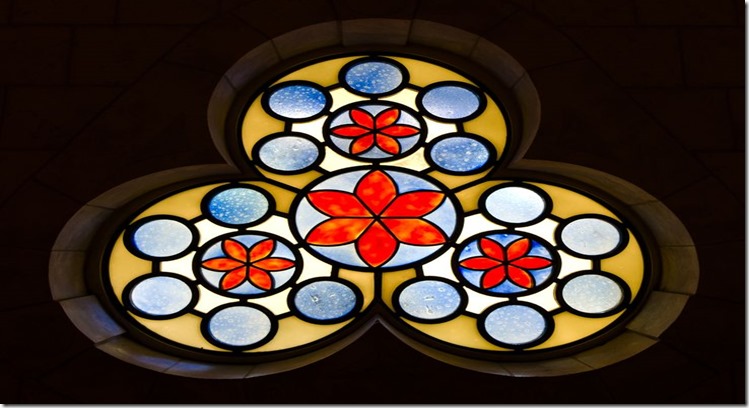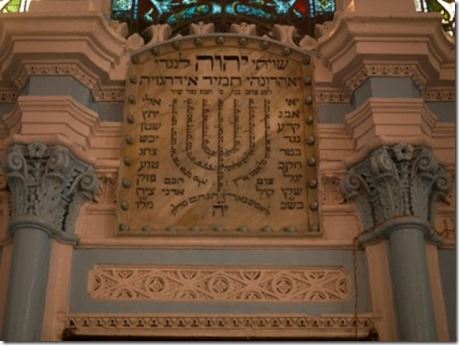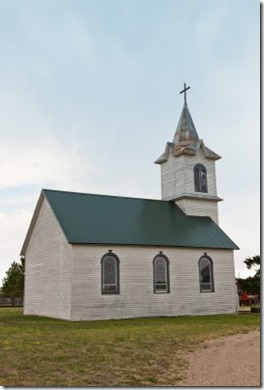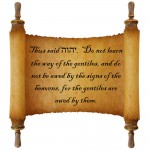 We have determined in a previous article “ You shall have a holy convocation” what this phrase actually means. We have learned that although assembling is not commanded on the Sabbath and Feast days, it is only natural to do so and to our benefit. We know that we need each other. We, as believers, therefore, can and should assemble with each other whenever we can.
We have determined in a previous article “ You shall have a holy convocation” what this phrase actually means. We have learned that although assembling is not commanded on the Sabbath and Feast days, it is only natural to do so and to our benefit. We know that we need each other. We, as believers, therefore, can and should assemble with each other whenever we can.
In this study, we will investigate what we know, in our time, as an assembly and how this compares with what was done in Biblical times. We shall also study how and when this originated. This history is important for our better understanding.
Where are we to assemble?
Are we to assemble in a specific place when we assemble? Do we have to go to a church or synagogue? What is the history of what we know today as churches and synagogues? Why do people assemble in a specific structure built for this purpose? Is this Scriptural? Are we commanded to worship in a special building?
Questions, questions and more questions. When you start to study something, just more questions arise…
We shall first study what we think to be the origin of what we know today as places of worship, to see if it is indeed so. Was the tabernacle the first building used for worship? Is this the origin of the modern church or synagogue?
The Tabernacle
The tabernacle, which was erected in the wilderness, by order of YHVH, is the first reference we find in Scripture of a building related to the worship of YHVH. What was the purpose of the Tabernacle? What does Scripture teach?
Exodus 25:8–9
8 “Let them construct a sanctuary for Me, that I may dwell among them. 9 “According to all that I am going to show you, as the pattern of the tabernacle and the pattern of all its furniture, just so you shall construct it.
The tabernacle was a sanctuary, a holy or set apart place, for YHVH to dwell with Israel. YHVH is holy, He therefor requires a holy place to dwell in. This tabernacle was patterned according to the heavenly tabernacle shown to Moses on the mountain (Ex 25:40.) On earth as in heaven (Matt 6:10.) The tabernacle was a physical representation of YHVH’s spiritual dwelling place in the heavenly realm.
The Hebrew word “miqdas” was translated as “sanctuary.”
5219 ×žÖ´×§Ö°×“Ö¸Ö¼×©× (miq·dÄÅ¡):
o sanctuary, shrine, temple, i.e., a construction, either moveable or with a permanent foundation which is consecrated and recognized as a sacred place (Ex 25:8; Eze 45:3);
o sacred thing, i.e., an implement, vessel, or product which is used for consecrated ritual duties (Nu 10:21; 18:29+), 1
Why was this structure called a tabernacle?
Leviticus 26:11
11 ‘Moreover, I will make My dwelling among you, and My soul will not reject you.
The word that was translated as dwelling is “miskan” or tabernacle.
5438 מִשְ×כָּן (miš·kÄn): n.masc.;
o tabernacle, i.e., a relatively large, portable dwelling, used as a central place of worship, as the dwelling place of God (Ex 25:9; Lev 15:31);
o tent, i.e., a portable dwelling, made of cloth, leather, or animal hair, with poles and a superstructure for holding it up (Nu 16:24);
o dwelling place, habitat, i.e., a place where one dwells, with no focus on the structure (Job 18:21; 39:6);
o tomb, grave, i.e., a place where the dead bodies are interned (Isa 22:16+), note: in context, a new, rock-hewn tomb;
o house, formally, tent, i.e., a permanent structure where one lives, as an extension of a tent as a portable dwelling (Jer 9:18[EB 19]; 30:18; 51:30)1
We also know from Scripture that YHVH really dwelled there.
Exodus 40:34
34 Then the cloud covered the tent of meeting, and the glory of YHVH filled the tabernacle.
We see in this verse in Exodus 40, that the tabernacle was also referred to as the tent of meeting. Also in Exodus 35:
Exodus 35:21
21 Everyone whose heart stirred him and everyone whose spirit moved him came and brought YHVH’s contribution for the work of the tent of meeting and for all its service and for the holy garments.
The Hebrew word “ohel” is translated as tent and “moed” as meeting.
ʾÅ·hÄ›l mô·ʿēḠTent of Meeting, i.e., another name for the Tabernacle, the official portable worship tent, with a focus that this tent was only used by appointment, located in a certain place, and authorized persons (Ex 27:21)1
The tabernacle or “tent of meeting” was literally a meeting place at an appointed time or by appointment. This is what YHVH said to Moses about the Tabernacle, when He gave him the instructions.
Exodus 25:22
22 “There I will meet with you; and from above the mercy seat, from between the two cherubim which are upon the ark of the testimony, I will speak to you about all that I will give you in commandment for the sons of Israel.
This tabernacle is about YHVH. We have seen in the previous article “ You shall have a holy convocation” that to have a holy convocation on the appointed times, which includes the Sabbath, is not about fellowship with other believers. It is about a special appointment between YHVH and His people.
It is also interesting to note that when the people did assemble, they assembled at the door of the tent of meeting. It was not your typical house of worship, where everybody went in and had a service.
Exodus 29:42
42 “It shall be a continual burnt offering throughout your generations at the doorway of the tent of meeting before YHVH, where I will meet with you, to speak to you there.
The meeting place was outside the tabernacle at the doorway of the tent of meeting, and it was intended to be this way throughout their generations. The main reason for building the tabernacle was not to house a religious service, that was not the purpose; it was YHVH’s dwelling place.
To have the meeting outside the door of the tent of meeting was also practical. Considering the size of the courtyard,(the courtyard was 150 feet by 75 feet or 45, 7m by 22. 86m) it makes perfect sense. You would be able to fit approximately 5000 people into this space if it was empty.
So, in conclusion, we have learned, thus far, that the tabernacle was a holy, or set apart place, erected to make it possible for YHVH to dwell among His people.
The tabernacle had been in use for 479 years, before the foundation was laid for the first Temple – King Solomon’s Temple.
The Temple
Did YHVH tell the Israelites to build the Temple? No, it was King David who wanted to build a house for YHVH.
2 Samuel 7:1–2
1 Now it came about when the king lived in his house, and YHVH had given him rest on every side from all his enemies, 2 that the king said to Nathan the prophet, “See now, I dwell in a house of cedar, but the ark of Elohim dwells within tent curtains.â€
This was YHVH’s reaction to this:
2 Samuel 7:4–7
4 But in the same night the word of YHVH came to Nathan, saying, 5 “Go and say to My servant David, ‘Thus says YHVH, “Are you the one who should build Me a house to dwell in? 6 “For I have not dwelt in a house since the day I brought up the sons of Israel from Egypt, even to this day; but I have been moving about in a tent, even in a tabernacle. 7 “Wherever I have gone with all the sons of Israel, did I speak a word with one of the tribes of Israel, which I commanded to shepherd My people Israel, saying, ‘Why have you not built Me a house of cedar?’ †’
YHVH continues to tell David through the prophet Nathan that his son will build a house for Him.
2 Samuel 7:12–13
12 “When your days are complete and you lie down with your fathers, I will raise up your descendant after you, who will come forth from you, and I will establish his kingdom. 13 “He shall build a house for My name, and I will establish the throne of his kingdom forever.
King David’s son, Solomon, built this temple. David purchased a threshing floor and accumulated gold, silver and most of what would be needed to build the temple. This is what YHVH said to Solomon concerning this house:
1 Kings 6:12–14
12 “Concerning this house which you are building, if you will walk in My statutes and execute My ordinances and keep all My commandments by walking in them, then I will carry out My word with you which I spoke to David your father. 13 “I will dwell among the sons of Israel, and will not forsake My people Israel.†14 So Solomon built the house and finished it.
Please note what the requirements are for YHVH to dwell in the Temple. This is very important! He said: “if you will walk in My statutes and execute My ordinances and keep all My commandments by walking in them, then I will carry out My word with you which I spoke to David your father. 13 “I will dwell among the sons of Israel, and will not forsake My people Israel.”
Remember this as we continue this study.
It took Solomon seven years to finish the Temple. The Temple was dedicated and the glory of YHVH filled the house.
1 Kings 8:10–11
10 It happened that when the priests came from the holy place, the cloud filled the house of YHVH, 11 so that the priests could not stand to minister because of the cloud, for the glory of YHVH filled the house of YHVH.
We see later the glory of YHVH departing from the Temple due to the sin of the people.
Ezekiel 10:18
18 Then the glory of YHVH departed from the threshold of the temple and stood over the cherubim.
We see, once again, the Temple is the dwelling place of YHVH (under certain conditions.) It was not built as a place to assemble. This is also confirmed by what David said:
The Temple is not for man, but for YHVH
1 Chronicles 29:1
1 Then King David said to the entire assembly, “My son Solomon, whom alone Elohim has chosen, is still young and inexperienced and the work is great; for the temple is not for man, but for YHVH Elohim.
Why is this important?
This is important, because we have been taught that the church or synagogue replaced the Temple. This is simply not true. The Temple was YHVH’s dwelling place , not a place of assembly as we have been taught. When the people did assemble, they did so outside the Temple or near the Temple (similarly with the tabernacle.)
Nehemiah 8:1
1 And all the people gathered as one man at the square which was in front of the Water Gate, and they asked Ezra the scribe to bring the book of the law of Moses which YHVH had given to Israel.
The Temple had another function as well. Here is a quote from the Anchor Yale Bible Dictionary.
Unlike religious structures or institutions in today’s Western world, which are usually seen as functioning apart from institutions of political power, the Jerusalem Temple, like that of other temple buildings in the ANE, was inextricably linked to political rule. Furthermore, although it has been customary to project onto the Jerusalem Temple our contemporary experiences with religious architecture as places of worship for the community of the faithful, the Temple like its ancient counterparts played a somewhat different religious role. The temple building itself was not a place of public gathering and prayer, although its courtyards were the scene of such activity. Rather, the Temple in conception was a dwelling place on earth for the deity of ancient Israel and in this way, too, was fundamentally different from the religious buildings (synagogue, church, mosque) of postbiblical times.2
So where does this leave us regarding places of assembly? Where does it originate from, if not from the tabernacle or the Temple. Let us first look at the history of the Synagogue.
The Synagogue
 When you hear the word synagogue, you might think of a building where Jews congregate, with Rabbi and liturgy and men and women sitting separately. Is this what is meant when this word is used in Scripture? When was the first synagogue built? We shall start off by looking at the meaning of the word synagogue and then some history.
When you hear the word synagogue, you might think of a building where Jews congregate, with Rabbi and liturgy and men and women sitting separately. Is this what is meant when this word is used in Scripture? When was the first synagogue built? We shall start off by looking at the meaning of the word synagogue and then some history.
The word synagogue is used 68 times in the Apostolic writings (New Testament.) This word was initially used for a gathering of people, but later became the name of the building where people assembled for religious purposes. This is very important to know, because it will change our understanding. If we were to read “assembly” instead of “synagogue” (meaning a building,) it gives us a slightly different understanding. Here is the definition from the Dictionary of Biblical Languages:
5252 συναγωγή (synagÅgÄ“), ῆς (Ä“s), ἡ (hÄ“): n.fem.
o assembly, a meeting (Jas 2:2; Rev 2:9), for another interp, see last;
o congregation of Jews (Ac 9:2; Ac 13:42 v.r.);
o synagogue, a place (Lk 7:5; Jas 2:2)1
When you consider the meaning of the word given by this lexicon, you see that this word synagogue primarily means to assemble or an assembly. It is also interpreted as a meeting place of Jews, a synagogue like we know today. However, we do not have enough historical proof to say with absolute certainty that every time this word was used in the Apostolic writings; it meant a building where Jews congregated. The translators interpreted it according to their understanding. You will see how this lead to a clear division between Jews and Christians.
We need to go and read every reference where the word synagogue was used with this understanding. We see the same happening with the word “ekklesia,” but we will look at it in more detail later. Much bias is translated into our Bibles, specifically where this is concerned.
This next reference is interesting, here; the translators inserted “the meeting of” before the word “synagogue.” They probably inserted it to make it more understandable or to fit their bias; if they have translated it as “assembly,” it would have made perfect sense without this insertion. Read it again and see how, when you read this, a picture is formed in your mind of people leaving a building. However, it may not have been a synagogue as we know it…
Acts 13:43
43 Now when the meeting of the synagogue had broken up, many of the Jews and of the God-fearing proselytes followed Paul and Barnabas, who, speaking to them, were urging them to continue in the grace of Elohim.
Here is another interesting reference, insert assembly here instead of synagogue and you will see how your understanding changes.
Acts 15:21
21 “For Moses from ancient generations has in every city those who preach him, since he is read in the synagogues every Sabbath.â€
Was this a physical building where Jews congregated, or could it have been an assembly of Torah observant believers in Y’shua? Think about this…
Here is a quote from the International standard Bible Encyclopedia:
A. Synagogue Gk synagÅgḗ (derived from sýn + ágÅ, “to bring/come together, congregateâ€) could be used of any assembly of persons, animals, or things (LSJ, pp. 1691f; TDNT, VII, 799–801). In secular Greek it was generally not applied to the place or house of meeting. It was used in LXX to translate Heb Ë“Ä“á¸Ã¢, “congregation,†which could be used of animals (Ps. 68:30 [MT 31], RSV “herdâ€; Jgs. 14:8, “swarmâ€) as well as angels (Ps. 82:1; RSV “the divine councilâ€; NIV “the great assemblyâ€) and people (Ps. 7:7 [MT 8]). Ë“Ä’á¸Ã¢ usually refers to the congregation of Israel. SynagÅgḗ is used sometimes to translate Heb qÄhÄl, “assembly, convocation, congregation†(35 times according to TDNT, VII, 802), but qÄhÄl is more commonly translated by ekklÄ“sÃa. In the OT, synagÅgḗ principally refers to the whole congregation of Israel assembled for cultic purposes as a religious community or assembled for legal purposes as a nation (cf. TDNT, VII, 804). The shift in meaning to refer to a local congregation is found in the Apocrypha, where Judaism as a whole is described as synagÅgaà Israel (Ps. Sol. 10:7) or synagÅgás hosÃÅn, “assemblies of holy ones†(17:16), whereas the local congregation is called hḗ synagÅgḗ (Sir. 4:7); but even in the Apocrypha, as in the OT, synagÅgÄ“ is not used for the place or house of assembly.3
Here the word “synagogue” is defined by the Anchor Yale Bible Dictionary:
The meeting place and prayer hall of the Jewish people since antiquity. During Second Temple times the term “synagogue†referred both to a group of people and/or a building or institution. Although these notions are not mutually exclusive, it is quite probable that at its inception the synagogue did not refer to an actual building but to a group or community of individuals who met together for worship and religious purposes. 4
What can we learn from history? When did the synagogue as a building emerge? Here is a quote from the Archeological Encyclopedia of the Holy Land. According to this source it was in the late 2nd and early 3rd Century AD. Take note, the writer states “the synagogue as a well defined type of building.” There could have been places of assembly that were not well defined in earlier times, like the homes of believers, but more on this later.
The synagogue, as a well-defined type of building, dates back to the late 2nd century and early 3rd century AD, both in the Diaspora (Miletus, Priene and Sardis) and in Palestine (the Galilean synagogues). The Palestinian synagogues have been classified, according to their plan and decoration, into three chronological types: early (3rd–4th centuries); transitional (4th–5th centuries), and late (5th–7th centuries).5
Here is some more history on the origin of the Synagogue from the Eerdmans’ Dictionary of the Bible.
The exact origin of the synagogue is unknown, and scholars continue to debate whether it emerged during the Babylonian Exile or in the Hellenistic period. Those who argue for an exilic date believe that the synagogue arose as a place where Jews, removed from the Jerusalem temple, could worship. Many believe that Ezekiel played a central role in establishing the synagogue (Ezek. 11:16), although others cite Jer. 39:8 as evidence for such houses of worship prior to the Exile. While it is probable that the synagogue existed prior to the Hellenistic period, its absence in Ezra and Nehemiah suggests that the Jews who returned from the Exile were unfamiliar with the institution. At present there is no direct textual or archaeological evidence for the existence of pre-Hellenistic synagogues.
The earliest unambiguous documentary evidence for the synagogue is an inscription from Egypt, which records the construction of a synagogue building during the reign of Ptolemy III Euergetes (247–221 B.C.E.). 1st-century B.C.E. Egyptian synagogue inscriptions have led some scholars to propose the origin of the synagogue in the diaspora of the Hellenistic period, possibly within Egypt itself. However, the exact date and locale of the synagogue’s origin remains a mystery.
We are including the next part of this quote as well, although this is, in our opinion, the translator’s interpretation because we have seen earlier that we don’t have that much archeological proof for this. However, it could be true, but we do not know for sure how established is was at the time of Y’shua.
Although no clear literary evidence for Palestinian synagogues exists prior to the Maccabean period, numerous references to Galilean and Jerusalem synagogues in the NT and Josephus suggest that sabbath worship within synagogue buildings is already an established institution prior to the 1st century C.E. (e.g., Matt. 4:23; Mark 1:21; Luke 4:16–30; 7:5; Acts 13:5, 14–15, 43; 14:1; 15:21; Josephus BJ 2.285–91; Vita 280).6
Here is the quote from Josephus Antiquities of the Jews that is mentioned in the previous quote. Here, we see the word “synagogue” referring to a building. What is the historical context? This was in the time of King Herod Agrippa. Claudius was Ceaser at the time and the context is when Theophilus was removed as high priest. He was high priest from 37 to 41 AD. So this took place in 41 AD.
From this, we can conclude that a synagogue could have existed in the year 41 AD in Doris. There are also some Scripture references that can only refer to synagogue as a building.
Luke 7:5
5 for he loves our nation and it was he who built us our synagogue.â€
Acts 18:7
7 Then he left there and went to the house of a man named Titius Justus, a worshiper of Elohim, whose house was next to the synagogue.
This proves that synagogues could have existed in the time of Y’shua. However, would there not be more archeological evidence if synagogues were indeed as widespread as the translators want us to believe? Our point is that we do not believe that every reference to synagogue meant a building, the Scripture is not clear on this, and this makes it open to interpretation. People also assembled in their homes, this would also be called a synagogue (assembly) we shall go into more detail when we look at the meaning of the word “ekklesia.” Just keep this in mind.
Here is some more information regarding early 1st-century synagogues from the Eerdman’s dictionary of the Bible.
Archaeology has provided physical evidence of 1st-century B.C.E.–1st-century C.E. synagogues in Palestine and the Diaspora. The earliest known synagogue is preserved on the Aegean island of Delos, whose Jewish community is mentioned both by Josephus and in inscriptions. This synagogue, built in the 1st century B.C.E., continued in use throughout the 1st and 2nd centuries C.E. A 1st-century C.E. synagogue was also discovered in the Roman part of Ostia, which remained in use until the 4th century. Although other early diaspora synagogues have been excavated, they postdate the NT period.
Our best evidence for the appearance of the NT synagogue comes from Palestine, where three pre–70 C.E. synagogues have been excavated, at Gamla, Masada, and Herodium. Although some scholars suggest the existence of 1st-century C.E. Palestinian synagogues at other sites, such as Migdal and Capernaum, the evidence is inconclusive. Of the known pre–70 C.E. synagogues, only the one at Gamla was originally designed and constructed for Jewish worship. Those at Masada and Herodium were secular meeting halls only later converted into synagogues. These three synagogue buildings closely resemble one another, and may have derived their design from secular assembly halls of the Hellenistic period.
The Gamla synagogue, constructed between the latter part of the 1st century B.C.E. and the first half of the 1st century C.E., was destroyed by the Romans in 67 C.E. It is the oldest known synagogue found in Israel, and best illustrates the appearance of the NT era synagogue building…. The synagogue’s most important functions were as a place for worship, prayer, and religious study. The Theodotus inscription, discovered in Jerusalem and believed to date to the early 1st century C.E., describes a Jerusalem synagogue founded as a place for “the reading of the law and the teaching of the precepts†(cf. Luke 4:16–20). The very design of the Palestinian synagogue, with benches along all four walls, facilitated worship by focusing the congregation’s attention toward the speaker, as reflected in NT accounts of synagogue services (Mark 6:1–5; Luke 4:16–30; Acts 13:13–16). By NT times, synagogue worship was already highly structured, and consisted of readings from the Torah and Prophets followed by an address or sermon (e.g., Luke 4:15–30; John 18:20; Acts 13:15). The seating within the synagogue was arranged in a certain order, with prominent places reserved for distinguished members (Mark 12:39 par.; Luke 20:46). Additional synagogue functions included its use as a general assembly hall for secular meetings and correction (Matt. 10:17; 23:34; Mark 13:9; Acts 22:19; 26:11; Josephus Vita 280). Epigraphic evidence, describing pre–70 C.E. diaspora synagogues, also documents communal means and slave manumissions conducted within the synagogue building.8
From this quote, we see that the earliest synagogues were probably secular meeting halls converted into synagogues. Here is an illustration of what a synagogue from the 1st century AD might have looked like ..
Reconstruction of a typical synagogue of the first century A.D. showing the large inner room where the men gathered and its loft above where the women gathered. This particular drawing is patterned after the synagogue at Capernaum.9
From the above quotes, we get some background information as to the origin and functions of Synagogues. Except for the Tabernacle, which was commanded by YHVH, no other structure or house was commanded. David wanted to construct a house for YHVH; YHVH approved it and the Temple was built by Solomon, his son. We know from Scripture that YHVH dwelled in the Tabernacle and also in the Temple. However, we furthermore know from Scripture that His glory left the Temple due to sin (Eze 10:18-19.)
There is a possibility that synagogues originated from the time of exile in Babylon, but there exists not enough conclusive proof. Even scholars and historians are not in agreement about this.
We also learned that we have to be careful how we interpret this word. The word may imply an assembly of people or a synagogue. The context might tell us which one, but sometimes we just don’t know.
Now that we have learned a bit more about the origin of the Synagogue, where does the church fit in?
The church
The church and going to church is a concept most of us grew up with. When you hear the word church, a picture of a building with a tower emerges in your mind. Is this what is meant when the word church is used in Scripture? Is it about a building to gather in? The word is “ekklesia†is not a “New Testament†only concept. The word “ekklesia†originates from the Hebrew word “qahal. We find proof of this in the Septuagint. The Septuagint is a Greek translation of the Hebrew Bible that was done before Y’shua’s time on earth.
The Greek word “ekklesia” is usually translated as church in the Apostolic writings. Here it is defined by the Dictionary of Biblical languages.
1711 á¼ÎºÎºÎ»Î·ÏƒÎ¯Î± (ekklÄ“sia), ας (as), ἡ (hÄ“): n.fem.;
o congregation, an individual assembly of Christians (or OT believers Ac 7:38; Heb 2:12), usually with leaders who conform to a standard, and have worship practices, with members interacting, more or less local (Mt 18:17; 1Ti 3:5; 1Co 11:16–22; Jas 5:14; Rev 1:4; 1Pe 5:13 v.r.);
o church, the totality of all congregations of Christians at all times (Mt 16:18);
o assembly, gathering of persons for a purpose, even riotous (Ac 19:32, 39, 40)1
We can certainly learn much from these resources, but do you see what we said before, how the translators transfer their bias into the translations. If you think about the Scripture in a Hebrew context, how can “ekklesia” be an assembly of Christians? According to these translators, only two references apply to “OT believers.” We know these believers referred to in Acts, and Hebrews were Torah observant believers in Y’shua and so were those spoken of in Matthew. With this, a word of caution, these lexicons are interpretations by humans, treat it that way, as a guideline. These people certainly are more learned in the languages than we are, but their interpretation is sometimes tainted with their bias. Ok, off my soapbox, let us continue…
So if “ an assembly of Christians” is not the true meaning of the word “ekklesia,” what is? Here is the word “ekklesia” defined by a free online dictionary. This definition also gives us the historical meaning of the word, which is more accurate. It, furthermore, points out to us that in Christianity, it refers to a congregation.
ecclesia [ɪˈkliËzɪə]
n pl -siae [-zɪˌiË]
1. (Christianity / Ecclesiastical Terms) (in formal Church usage) a congregation
2. (Historical Terms) the assembly of citizens of an ancient Greek state
[from Medieval Latin, from Late Greek ekklēsia assembly, from ekklētos called, from ekkalein to call out, from kalein to call]10
From these definitions and the Scriptural references, wherein this word “ekklesia” is used; we see that the Greek word “ekklesia” mostly refers to the group of believers or the body of believers; the assembly of YHVH, the called out ones. As said before, the Hebrew word “qahal” would be translated “ekklesia” in Greek (this was also done in the Septuagint.)
It does not refer to a building and does not refer to “Christian believers” per se, but to believers. These believers were Torah observant believers in Y’shua.
We have also seen before, in the section about the synagogues, that the people assembled in homes, especially in the Greek towns. We have a few references that confirm this.
Romans 16:5
5 also greet the church (assembly) that is in their house. Greet Epaenetus, my beloved, who is the first convert to Messiah from Asia.
1 Corinthians 16:19
19 The churches of Asia greet you. Aquila and Prisca greet you heartily in the Master, with the church that is in their house.
See also Col 4:15 and Phil 2. Believers living in Greek towns usually assembled for prayer in private homes. If an assembly member was wealthy, the synagogue might have been held in a home like this one. Here is a picture of an ancient home synagogue.
So what do we understand when we read Acts 15:21?
Acts 15:21
21 “For Moses from ancient generations has in every city those who preach him, since he is read in the synagogues every Sabbath.â€
Did new believers go to the Synagogue on the Sabbath or did they go to an assembly of believers? We have seen before, in the section about a synagogue that this word means an assembly of people. It is said in this verse that Moses was read in the assembly every Sabbath, and immediately we conclude that it must be a Jewish synagogue. We have to break down all these false precepts, because that is what it is. The believers in Y’shua would also read and study the Torah, for they were obedient to the commandments. This word “synagogue” could therefor refer to an assembly of Torah observant believers in Y’shua.
This study probably seems a bit like a history lesson to you, but we need to understand the historical context of the Scripture in order to understand what is meant. We need to know where the concept of church originated from. The church, as we know it today is a man-made system, an organization. It probably originated from synagogues which originated from places of assembly, be it homes or halls. Similarly, with a synagogue, be it Messianic, Nazarene or orthodox. It is a man-initiated system. Was it the intend of YHVH to make us part of a system? Do you think we have to be a part of a system and observe Torah as they do, to be justified?
It could lead to arrogance, in my opinion, for some may think “we observe the Torah better than you do; we therefore do not associate with you.” We certainly cannot generalize here, but that is a danger. What did Paul have to say to Peter in the book of Galatians? Peter, who, before, freely associated with gentiles, now kept himself separate after starting to associate with those of the “circumcision.” He did not want to associate with “gentiles” any more (Gal 2:12).
Why did we put circumcision and gentiles in brackets? Because the reference about being of the circumcision points to a group of people, the Jews, who believed in justification through the keeping of the law. Believers who were formerly gentiles, were still being seen as gentiles, the other group “of the circumcision” separated themselves from them. We know from our study “Who is Israel” that every believer is justified through faith and becomes a part of Israel. There is no distinction between Jews and former gentiles. They are alike in YHVH’s eyes, and the same is required of them. You can learn more about this in the study we did of the book of Galatians.
So where did Christianity originate from?
 So if this “church†does not refer to the “Christian church,†where did Christianity originated from? We know that Christianity originated from the followers of Y’shua. Y’shua was a Jew and so were most of His followers. He came for the lost sheep of Israel. However, in His great mercy, He accepts gentiles as well. These gentiles and Jewish believers in Y’shua, together, formed the assembly (what was translated as the church) in the Apostolic writings. These followers of Y’shua were Torah-observant, just as He was. He was the perfect example and said:
So if this “church†does not refer to the “Christian church,†where did Christianity originated from? We know that Christianity originated from the followers of Y’shua. Y’shua was a Jew and so were most of His followers. He came for the lost sheep of Israel. However, in His great mercy, He accepts gentiles as well. These gentiles and Jewish believers in Y’shua, together, formed the assembly (what was translated as the church) in the Apostolic writings. These followers of Y’shua were Torah-observant, just as He was. He was the perfect example and said:
Matthew 5:17–19
17 “Do not think that I came to abolish the Law or the Prophets; I did not come to abolish but to fulfill. 18 “For truly I say to you, until heaven and earth pass away, not the smallest letter or stroke shall pass from the Law until all is accomplished. 19 “Whoever then annuls one of the least of these commandments, and teaches others to do the same, shall be called least in the kingdom of heaven; but whoever keeps and teaches them, he shall be called great in the kingdom of heaven.
After Y’shua was taken up into heaven, His apostles continued in the Way, in obedience to the commandments. They were persecuted and through the ages that followed persecuted even more. This led them to gradually abolish anything that can identify them as believers or anything that can associate them with their Jewish brothers. That is how the “Christian” faith originated, stripped from most of what identified them as followers of the Way. Some of which are the Sabbaths, the Feasts of YHVH, circumcision and the dietary laws.
They also adopted some pagan practices along the way and incorporated it into their worship. Constantine was instrumental in some of these. Some include Sunday worship, Christmas, Easter, Halloween and many other festivals not described in Scripture. This is, in a nutshell, how what we know today, as Christianity originated; a mixed religion, severed from its foundation found in the Torah.
The Church buildings we find all over the world attest to this, with its tower and other pagan symbolism you may find in it. These buildings probably originated from the houses and later assembly halls that were used by the people of the Way to congregate in.
This does not mean that we now condemn Christians! On the contrary, they are our brothers. We need to live Torah in such a way that our fruit becomes a living testimony to them. We are, furthermore, to pray that YHVH will reveal His truth to them and pray that we may be used for this purpose. YHVH changes hearts, not us, but we can be instruments in His hands. Do not, for this reason, call them pagans and disassociate with them… that is not good fruit!
Galatians 5:22–23
22 But the fruit of the Spirit is love, joy, peace, patience, kindness, goodness, faithfulness, 23 gentleness, self-control; against such things there is no law.
Conclusion
We have had a look at the origin and purpose of the Tabernacle and Temple, and we have looked into the origin of synagogues and the church. We have learned that these words: “synagogue” and “church” were, in many cases, translated to fit the bias of the translators. These words, though very similar in meaning are often used by translators to create a clear division between Jews and Christians and also to justify their replacement theology. The word “synagogue” is primarily understood by translators to mean the building wherein Jews assembled or the congregation of Jews and the “ekklesia” to mean “the assembly of Christians” However, when we look up at the meaning of the words and study the historical context, we see that this was not the original intention. We know that the early believers followed Y’shua (who was a Jew), and we know that He was obedient to YHVH’s commandments. The “ekklesia” referred to in Scripture was Torah obedient believers in Y’shua, it was not a new religion called “Christianity,” but was a sect of Judaism.
The “ekklesia” refers to the body of believers, whereas the synagogue refers to the assembly of believers. For this reason believers in Y’shua could be part of both a synagogue (assembly) and the church (body of believers) at the same time.
We have also learned that assembling in a building was never commanded. We do not have to be part of an organization or system; we can assemble wherever we want. It is understandable that people who assemble together regularly, would want a place to assemble for practical reasons. It is therefore only natural that places like these would evolve over time. However, should these buildings become the focus of everything and should so much money be spent on it?
To change our thinking about this is not easy. I remember how difficult it was for me to go to an assembly at a home for the first time, after having been indoctrinated as a child that you have to belong to and go to a church. We have to get rid of these false teachings and understand and do what is really written in the Scripture. It is not easy to leave this all behind and change overnight, but we would like to urge you to study the Scripture and ask YHVH to reveal His truth to you, to all of us, so we can walk in the fullness of the truth of His Word.
2 Timothy 2:15
15 Be diligent to present yourself approved to Elohim as a workman who does not need to be ashamed, accurately handling the word of truth.
References
- Swanson, J. (1997). Dictionary of Biblical Languages with Semantic Domains : Hebrew (Old Testament) (electronic ed.). Oak Harbor: Logos Research Systems, Inc.
- Meyers, C. (1992). Temple, Jerusalem. In D. N. Freedman (Ed.), . Vol. 6: The Anchor Yale Bible Dictionary (D. N. Freedman, Ed.) (351). New York: Doubleday.
- Vol. 4: The International Standard Bible Encyclopedia, Revised. 1979–1988 (G. W. Bromiley, Ed.) (676). Wm. B. Eerdmans.
- Synagogue. (1992). In D. N. Freedman (Ed.), . Vol. 6: The Anchor Yale Bible Dictionary. 1992 (D. N. Freedman, Ed.) (251). New York: Doubleday.
- Negev, A. (1990). The Archaeological encyclopedia of the Holy Land (3rd ed.). New York: Prentice Hall Press.
- Atkinson, K. (2000). Synagogue. In D. N. Freedman, A. C. Myers & A. B. Beck (Eds.), Eerdmans dictionary of the Bible (D. N. Freedman, A. C. Myers & A. B. Beck, Ed.) (1260–1261). Grand Rapids, MI: W.B. Eerdmans.
- Josephus, F., & Whiston, W. (1987). The works of Josephus: Complete and unabridged. Peabody: Hendrickson.
- Atkinson, K. (2000). Synagogue. In D. N. Freedman, A. C. Myers & A. B. Beck (Eds.), Eerdmans dictionary of the Bible (D. N. Freedman, A. C. Myers & A. B. Beck, Ed.) (1261–1262). Grand Rapids, MI: W.B. Eerdmans.
- Dean Robert J., & Draper, C. W. (2003). Synagogue. In C. Brand, C. Draper, A. England, S. Bond, E. R. Clendenen & T. C. Butler (Eds.), Holman Illustrated Bible Dictionary (C. Brand, C. Draper, A. England, S. Bond, E. R. Clendenen & T. C. Butler, Ed.) (1545). Nashville, TN: Holman Bible Publishers.
- http://www.thefreedictionary.com/Ekklesia


![clip_image002[5] clip_image002[5]](https://www.setapartpeople.com/wp-content/uploads/2013/07/clip_image0025_thumb.jpg)








Leave a Reply